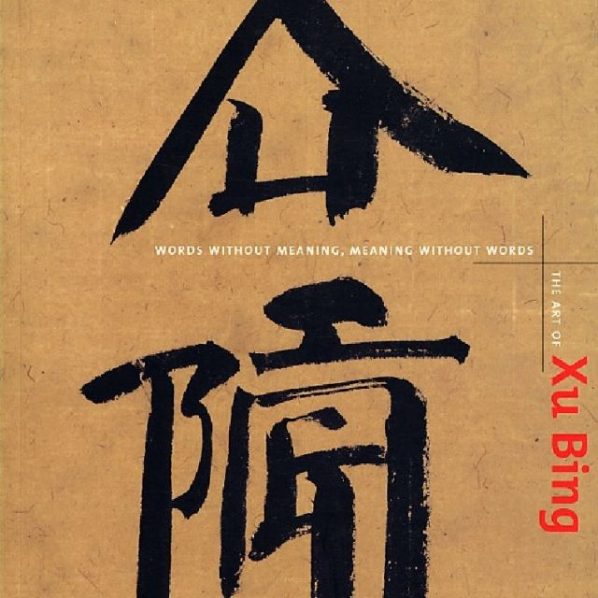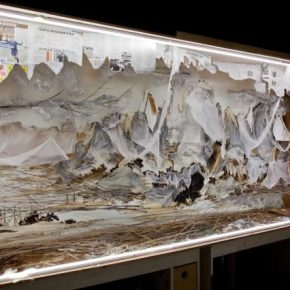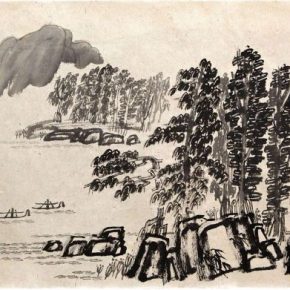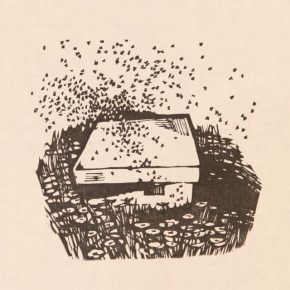
“. . . facing a real mountain, I wrote ‘mountain’ . . . where there was river water I wrote the character for ‘water’. The clouds shifted, the mountain colors changed, the wind blew and the grasses moved, the life around me appeared and disappeared; with a feeling of excitement, I recorded it all!” —Xu Bing, 2013 on his 1999 excursions in the Himalaya Mountains
INK studio is honored to present Xu Bing: Language and Nature organized by the artist’s long-standing curatorial partner, INK studio Artistic Director Dr. Britta Erickson. Xu Bing is widely recognized as one of the leading conceptual artists of language and semiotics working today. Indeed, many consider the relationship between humankind and language to be the dominant leitmotif of Xu Bing’s oeuvre. For Language and Nature, Erickson takes a fresh look at Xu Bing’s practice and explores its central theme of Nature. Specifically, it examines Nature’s relationship to human minds and human societies as embodied in two distinctly Chinese modes of signification: the pictorial character of Chinese writing and the language-like nature of Chinese painting.
Xu Bing and Britta Erickson first met in 1991 while working together on his first institutional exhibition outside of Asia, a major solo show at the Elvehjem Museum, Madison, Wisconsin. Xu Bing and Dr. Erickson re-united a decade later for Xu Bing’s solo exhibition Word Play: Contemporary Art by Xu Bing at the Arthur M. Sackler Gallery, America’s national gallery for Asian art in Washington D.C. Focusing on Xu Bing’s explorations of language, they premiered the artist’s new Landscript series of calligraphy-landscape paintings using brush, paper and ink, and staged three new installations—The Living Word, Reading Landscape, and Monkeys Grasp for the Moon—alongside definitive installations of Book from the Sky and Square Word Calligraphy, including a new version of Calligraphy Classroom. Aside from writing the seminal monograph Words without Meaning, Meaning without Words: The Art of Xu Bing, Dr. Erickson has directed the short documentary film The Enduring Passion for Ink: Xu Bing’s Semiotics and authored over a dozen catalog essays and journal articles on different aspects of Xu Bing’s artistic practice over the past 25 years.
Language and Nature incorporates works from six distinct but conceptually inter-related practices to chart Xu Bing’s systematic exploration of what he describes as nothing less than the “most essential and particular constituent of our [Chinese] culture.” Early WoodcutsIn Xu Bing’s early woodcuts such as the Shattered Jade Series (1978–1983) and Repetitions Series (1987–1988), Xu Bing explores the woodcut medium as a means of depicting his experience of rural life in China during the Cultural Revolution. Taking full advantage of the intaglio-relief medium of the woodcut, Xu Bing distills pictorial mark making to an essential language of lines and dots so irreducible, he seems to be creating iconic symbols of his experience. This basic iconic language of natural forms would prefigure Xu Bing’s subsequent and explicit explorations of nature and culture through language and its relationship to picture-making.
LandscriptIn 1999 while traveling in the Himalaya Mountains, Xu Bing began to sketch his experience of the landscape in the form of written characters. Indeed, he has said that he saw the landscape as characters. In the resulting Landscript series of ink and brush paintings on paper, Xu Bing extends the idea of the “living word”—that the forms of the natural world are the source for written language—to the creation of art, specifically landscape paintings. In the Chinese tradition, painting and language have always been linked through the brushwork of calligraphy and the imagery of poetry. In his Landscript series, Xu Bing reinvents this relationship by substituting the images of Chinese written characters for painted depictions of natural forms. By inserting the iconic-symbolic dimension of calligraphy into painting, Xu Bing not only redraws the language-imaging relationship in the domain of painting, but also re-enacts the introduction of calligraphic brushwork into painting but on terms completely of his own invention.
The Living WordExtending the concepts of Landscript to the physical, experiential mode of installation, Xu Bing created a series of three monumental installations The Living Word (2001), Monkeys Grasp for the Moon (2004), and Purple Breeze Comes from the East (2008). Here, Xu Bing re-performs Cang Jie’s original creative act of imaging written characters out of natural forms but in reverse: instead of natural forms giving rise to language signs, written characters return to their natural forms as “living words.” For Language and Nature, Xu Bing stages what he calls the “intaglio” or “white on black” edition of his iconic The Living Word installation in the character bird 鸟 transforms from its current Maoist simplified form back through its morphological history to its original natural form as a bird in flight.
Background StoryIn 2004 Xu Bing once again took up the landscape painting tradition as his subject, this time eschewing brush, ink, and paper in favor of installation and the light box. In this series, titled Background Story, the artist models each of his compositions after a well-known, historic masterwork, but renders them using only “non-art” materials such as dried plants and torn bits of plastic sheets, light and shadow. By showing us both the front—the iconic masterwork—and the back—the astonishing mixed array of materials that light and shadow indexically signify—Xu Bing questions the history and transmission of landscaping painting practice and asks how our relationship to the natural world gives meaning to such practices.
Mustard Seed GardenIn The Mustard Seed Garden Landscape Scroll (2010), Xu Bing discovers in the eponymous 17th century woodcut painting manual a comprehensive pictorial “dictionary” for disseminating the landscape painting tradition as both a “language” of socially-constructed signs or symbols and a hermeneutic tradition that gains contemporary meaning only through the learning, re-performance, re-interpretation and dissemination of canonical models or “texts.” Here, Xu Bing questions how a language that has its origins in nature can become purely a construction of culture and history.
Book from the Sky“Once in 1986, while thinking of something else, it occurred to me to make a book that no one would ever be able to read.” —Xu Bing, 2008
Artist and curator conclude Language and Nature with a special reading room where viewers can spend time quietly perusing original page spreads from Xu Bing’s original wood-block and moveable-type printing of Book from the Sky (1987–1991). This year being the 30th anniversary of this iconic work’sdebut installation at the Central Academy of Fine Arts in 1988, artist and curator both re-examined the four books comprising Book from the Sky and discovered that many of the characters that Xu Bing had devised suggest, in their construction, natural processes, formations, beings and ideas—trees, water flowing down mountains (or mountains being eroded by water?), animals with four legs, etc.—characters so animated they assert an existence and life of their own. Xu Bing recalls that these acts of imagination were in fact the seed that gave rise to so many questions about both the nature of language and the language of nature.
“Bing talks about how art reveals. Bing’s art has always revealed / hidden / revealed. But more important is what that approach touches upon in our shared humanity. From looking deeply into a work of art, sinking deeply into it, we understand something of our time, of culture, of the artist. The process of coming to fathom what that work of art presents—now, later, later still—actually reveals our inner self, to ourselves. The act of creating is not a simple one-way process: through creating, the artist’s self-understanding also grows.” —Britta Erickson, 2018
About the Artist Xu Bing (b. 1955) is widely recognized as one of the leading conceptual artists of language and semiotics working today. A recipient of a MacArthur Fellowship, he is celebrated for his “capacity to contribute importantly to society, particularly in printmaking and calligraphy.” Born in Chongqing, China in 1955, Xu grew up in Beijing where he studied printmaking at the Central Academy of Fine Arts. Trained as a printmaker, Xu’s work is informed by the Cultural Revolution, Chan Buddhism, and his keen interest in the relationship between meaning and words, writing, and reading. He has famously re-invented Chinese characters and the English alphabet, rendering Chinese nonsensical and English into legible Chinese characters, effectively challenging comprehension of both.One of his best-known works, the Book from the Sky (1987–1991), earned Xu international recognition in the late 1980s and the 1990s. The work is a massive installation of scores of volumes, and scrolls printed with over 1200 imagined Chinese characters, all of them cut by hand into wood printing blocks. Describing his art practice, Xu explains that his works “are all linked by a common thread, which is to construct some kind of obstacle to people’s habitual ways of thinking—what I call the ‘cognitive structures’ of the mind.”
Solo exhibitions of his work have been held at The Museum of Modern Art in New York, The Metropolitan Museum of Art in New York, and the British Museum in London, among other major institutions. In addition, Xu Bing has shown at the 45th and 51st Venice Biennales; the Biennale of Sydney and the Johannesburg Biennale among other international exhibitions.
Grants and Prizes
Southern Graphics Council Lifetime Achievement Award
International Association of Art Critics Award for “Best Installation or Single Work of Art in a Museum, New England”
The Youth Friends Award, NYC
Artes Mundi Prize
American Academy in Berlin Coca-Cola Fellowship
Fukuoka Asian Culture Prize
MacArthur Award
Pollock-Krasner Foundation Prize
ArtPace Foundation Resident Artist
About the Curator Britta Erickson, Ph.D. is an independent scholar and curator living in Palo Alto, California. She has curated major exhibitions at the Arthur M. Sackler Gallery, Washington, D.C. (Word Play: Contemporary Art by Xu Bing) and the Cantor Center for Visual Arts, Stanford University (On the Edge: Contemporary Chinese Artists Encounter the West). In 2007 she co-curated the Chengdu Biennial, which focused on ink art, and in 2010 she was a contributing curator for Shanghai: Art of the City (Asian Art Museum, San Francisco). Dr. Erickson has written numerous books, articles, and essays on contemporary Chinese art. She has produced a series of short films about ink painting entitled The Enduring Passion for Ink. Ms. Erickson is on the advisory boards of The Ink Society (Hong Kong) and Three Shadows Photography Art Centre (Beijing), as well as the editorial board of Yishu: Journal of Contemporary Chinese Art. In 2006 she was awarded a Fulbright Fellowship to conduct research in Beijing on the Chinese contemporary art market. Dr. Erickson received her Ph. D. in Art History, focusing on China, from Stanford University.Her publications include three books—The Art of Xu Bing: Words without Meaning, Meaning without Words (Seattle, 2001), On the Edge: Contemporary Chinese Artists Encounter the West (Stanford/Hong Kong, 2004), and China Onward; The Estella Collection: Chinese Contemporary Art, 1966-2006 (Humlebæk, 2007)—as well as biographical entries for Grove Art Online (Oxford, 2005) and numerous articles and essays. She is frequently a speaker at international symposia, invited as an authority on issues in contemporary Chinese art practice, collecting, and criticism.
About INK studio INK studio is an art gallery based in Beijing. Its mission is to present Chinese experimental ink as a distinctive contribution to contemporary transnational art-making in a closely-curated exhibition program supported by in-depth critical analysis, scholarly exchange, bilingual publishing, and multimedia production. INK studio curates three to four major solo projects per year with artists such as Bingyi, Dai Guangyu, He Yunchang, Li Jin, Li Huasheng, Wang Dongling, Yang Jiechang, and Zheng Chongbin and exhibits works of diverse media, including painting, calligraphy, sculpture, installation, performance, photography, and video. Since its inception in 2012, INK Studio has regularly appeared at art fairs such as the Armory Show (New York), Art Basel Hong Kong, and West Bund Art & Design (Shanghai) and placed works into major public collections, including the Metropolitan Museum of Art, Los Angeles County Museum of Art, Brooklyn Museum, and M+ Museum, Hong Kong.About the exhibition
Dates: Jul 14, 2018 - Sep 23, 2018
Venue: Ink Studio
Courtesy of the artist and Ink Studio, for further information please visit www.inkstudio.com.cn.


































